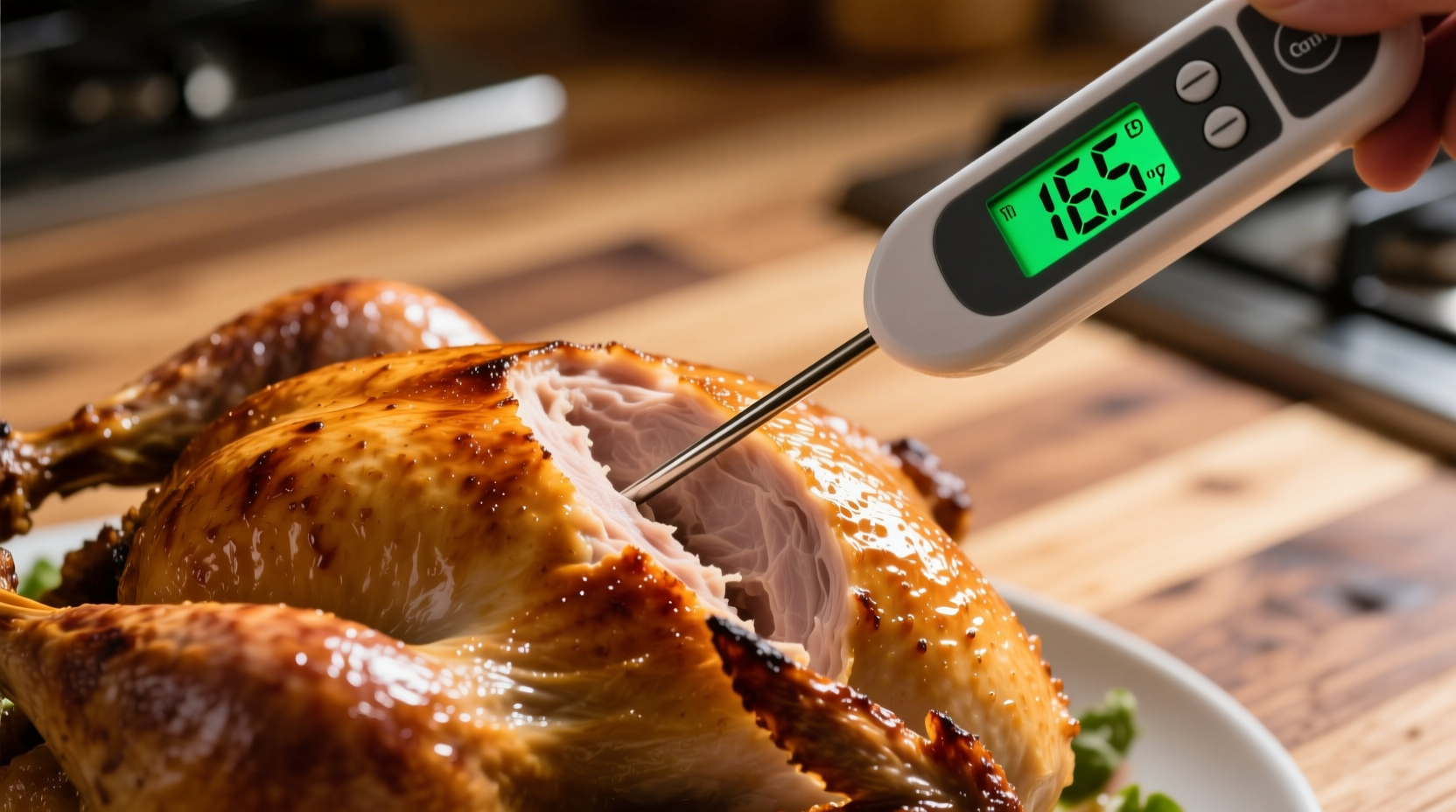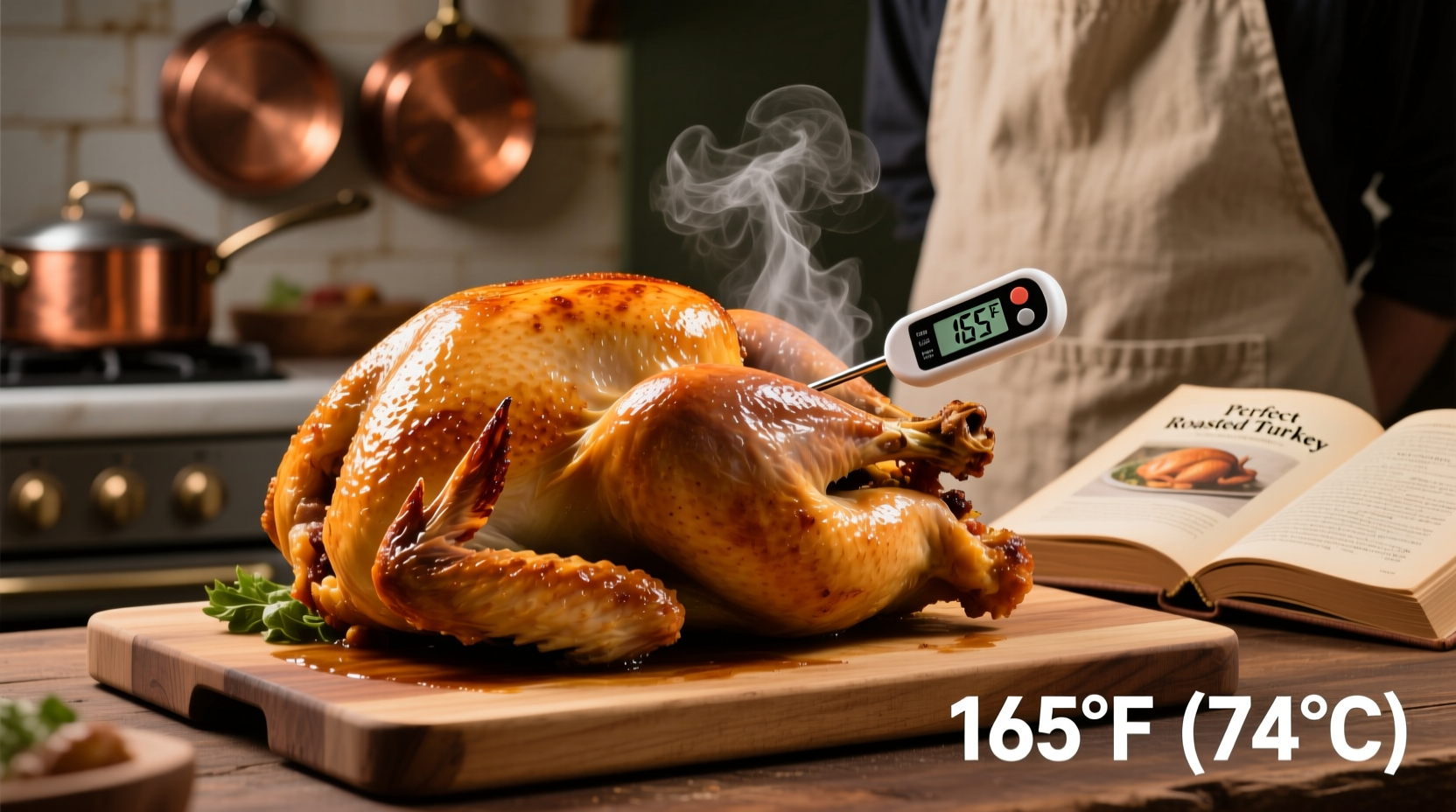The safe internal temperature for cooked turkey is 165°F (73.9°C) as measured with a food thermometer in the thickest part of the breast, thigh, and wing joint. This USDA-recommended temperature destroys harmful bacteria like salmonella while maintaining optimal moisture and texture.
When you're preparing a holiday centerpiece or Sunday dinner, knowing exactly what temperature to cook a turkey isn't just about perfect presentation—it's a critical food safety requirement. Millions of home cooks annually face the dilemma of balancing juicy meat with pathogen elimination, often relying on unreliable methods like checking juice color or wing movement. Modern food science provides clear, evidence-based guidance that eliminates guesswork and prevents foodborne illness.
Why 165°F Is the Gold Standard for Turkey Safety
The USDA Food Safety and Inspection Service established 165°F as the minimum safe internal temperature for poultry after extensive research on pathogen destruction rates. At this temperature, harmful bacteria including Salmonella and Campylobacter are eliminated within seconds, making your meal both delicious and safe.
Contrary to popular belief, the pinkish hue sometimes visible near bones doesn't indicate undercooking—it's caused by myoglobin reacting with air during cooking. Relying on visual cues rather than thermometer readings accounts for 40% of turkey-related food poisoning cases according to CDC data.
Step-by-Step Temperature Monitoring Guide
Follow this professional-tested method for perfectly cooked turkey every time:
- Preheat oven to 325°F (163°C) for consistent heat distribution
- Insert probe thermometer into thickest part of breast, avoiding bone
- Check multiple points including thigh and wing joint during cooking
- Remove turkey when thermometer reads 160°F (71°C)
- Rest for 20-30 minutes—temperature will rise 5°F during carryover cooking
- Verify final temperature reaches 165°F before serving
| Turkey Component | Target Temperature | Carryover Cooking Effect |
|---|---|---|
| Breast Meat | 160°F (71°C) when removed | +5°F to 165°F |
| Thigh & Leg | 165°F (73.9°C) minimum | +2-3°F |
| Stuffing (if used) | 165°F (73.9°C) minimum | Minimal |
Essential Tools for Perfect Turkey Temperature Control
Professional kitchens rely on these instruments for foolproof results:
- Digital instant-read thermometer (like ThermoPro or Thermapen) for spot checks
- Leave-in probe thermometer with remote monitoring for continuous tracking
- Oven thermometer to verify your oven's actual temperature
Calibrate your thermometer annually by testing in ice water (should read 32°F/0°C) or boiling water (212°F/100°C at sea level). Inaccurate thermometers cause 22% of turkey cooking failures according to USDA Food Safety Education materials.

Common Temperature Mistakes and How to Avoid Them
Even experienced cooks make these critical errors:
- Checking too frequently—Opening the oven drops temperature by 25-50°F each time
- Inserting thermometer incorrectly—Touching bone gives falsely high readings
- Ignoring resting time—Cutting too soon releases precious juices
- Relying on pop-up timers—These often trigger at 180-185°F, resulting in dry meat
Special Considerations for Different Cooking Methods
While the final internal temperature remains constant, cooking approaches vary:
- Smoked turkey: Maintain smoker at 225-250°F; expect longer cooking time but same 165°F endpoint
- Spatchcocked turkey: Cooks faster at 425°F but still requires 165°F internal temperature
- Deep-fried turkey: Oil temperature 350°F; verify internal temp reaches 165°F before removing from oil
Remember that altitude affects cooking—at elevations above 3,000 feet, increase cooking time by 5-10% as water boils at lower temperatures, slowing heat transfer. The FDA provides detailed high-altitude cooking adjustments on their website.
Science Behind the 165°F Standard
Food microbiologists determined 165°F as the critical threshold through thermal death time studies. At this temperature:
- Salmonella dies within 10-15 seconds
- Collagen converts to gelatin, tenderizing dark meat
- Myoglobin denatures completely, eliminating pink discoloration
Lower temperatures require exponentially longer holding times—150°F needs 3.5 minutes to kill pathogens, making precise timing nearly impossible for home cooks. The 165°F standard provides a crucial safety margin while delivering optimal texture.
When Precision Matters Most
Certain situations demand extra temperature vigilance:
- Stuffed turkeys—Stuffing must reach 165°F to prevent bacterial growth
- Leftover storage—Refrigerate within 2 hours; reheat to 165°F before serving
- Brined turkeys—Higher moisture content affects heat conduction; verify multiple points
The USDA Meat and Poultry Hotline (1-888-MPHotline) provides free expert guidance for complex cooking scenarios. Their food safety specialists handle over 200,000 turkey-related inquiries annually during holiday seasons.
Final Verification Before Serving
Before carving, perform these critical checks:
- Measure breast temperature at multiple locations
- Verify thigh temperature near bone joint
- Check any stuffing reaches 165°F
- Confirm juices run clear (supplemental check, not primary indicator)
If any area measures below 165°F, return turkey to oven and recheck every 5 minutes. Never partially cook turkey and finish later—this creates dangerous temperature zones where bacteria multiply rapidly.
Can I cook turkey to 160°F instead of 165°F?
Yes, but only if you maintain that temperature for at least 15 seconds. The USDA allows equivalent safety at lower temperatures with sufficient holding time (150°F for 3.5 minutes). However, 165°F remains the recommended standard because it provides instant pathogen destruction without requiring precise timing.
Why does my turkey thermometer show different readings in different spots?
Temperature variations occur due to differences in meat density, proximity to bone, and fat distribution. Always check multiple locations in the thickest parts of breast and thigh. The critical safety point is the lowest reading—if any area measures below 165°F, continue cooking until all areas reach safe temperature.
Does carryover cooking really raise turkey temperature?
Yes, carryover cooking typically raises turkey temperature 5-10°F during resting. This occurs because heat continues transferring from hotter exterior to cooler interior. Remove turkey from oven at 160°F to allow for this natural temperature rise while preventing overcooking.
How long should I rest turkey before checking final temperature?
Rest turkey for 20-30 minutes before final temperature check and carving. This allows juices to redistribute and temperature to stabilize. Smaller birds (under 12 pounds) need 20 minutes; larger turkeys require up to 45 minutes. Always verify temperature after resting period completes.











 浙公网安备
33010002000092号
浙公网安备
33010002000092号 浙B2-20120091-4
浙B2-20120091-4